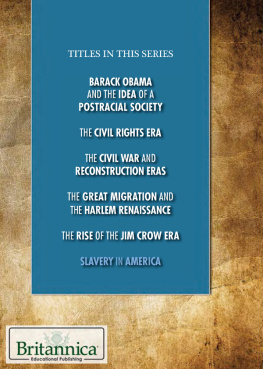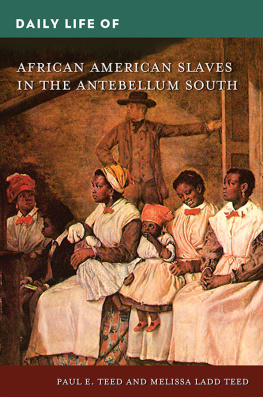Published by Louisiana State University Press
Copyright 2012 by Louisiana State University Press
All rights reserved
Manufactured in the United States of America
First printing
Designer: Barbara Neely Bourgoyne
Typeface: Whitman
Printer: McNaughton & Gunn, Inc.
Binder: Acme Bookbinding, Inc.
Library of Congress Cataloging-in-Publication Data
Zaborney, John J., 1967
Slaves for hire : renting enslaved laborers in antebellum Virginia / John J. Zaborney.
p. cm.
Includes bibliographical references and index.
ISBN 978-0-8071-4512-8 (cloth : alk. paper) ISBN 978-0-8071-4513-5 (pdf) ISBN 978-0-8071-4514-2 (epub) ISBN 978-0-8071-4515-9 (mobi)
1. SlaveryVirginiaHistory19th century. 2. SlavesVirginiaSocial conditions19th century. 3. SlaveryEconomic aspectsVirginiaHistory19th century. 4. SlavesEmploymentVirginiaHistory19th century. I. Title.
E445.V8Z33 2012
306.3'620975509034dc23
2012000531
The paper in this book meets the guidelines for permanence and durability of the Committee on Production Guidelines for Book Longevity of the Council on Library Resources.

IN LOVING MEMORY OF
Stuart Bruchey
John Hopewell
Marli Weiner
and
John and Eva Zaborney
DEDICATED TO
Kim Sebold
and
John and Delia Zaborney
ACKNOWLEDGMENTS
M any institutions and persons facilitated my completion of this book. I wish to thank Rand Dotson, my editor at the Louisiana State University Press, for his encouragement and guidance of my manuscript to publication. Thanks are also due Lee Sioles and others at LSU Press who spent their time and effort working with my manuscript and copy editor Lois Crum, whose sharp eyes and expertise enhanced the quality of this book immeasurably. I am also grateful to Charles Dew, who read earlier versions of the manuscript. Professor Dews expert evaluation and suggestions made the final product immensely better than it was. Any remaining errors or shortcomings are, of course, my own responsibility. Additionally, I wish to thank John Saillant, and also the Afro-American Historical and Genealogical Society, for permission to use previously published material.
In North Carolina and Virginia, the staff at the following archives were cheerful and helpful: the Southern Historical Collection, Wilson Library, at the University of North Carolina at Chapel Hill; the Rare Book, Manuscript, and Special Collections Library, William Perkins Library, at Duke University; the Earl Gregg Swem Library at the College of William and Mary in Virginia; the Albert and Shirley Small Special Collections Library at the University of Virginia; the Library of Virginia; the Virginia Historical Society; the Fairfax Circuit Court Archives at the Fairfax County (Virginia) Judicial Center; and the Sussex (Virginia) courthouse. My work was aided greatly by Andrew W. Mellon Research Fellowships at the Virginia Historical Society and by faculty development funds and a sabbatical leave awarded by the University of Maine at Presque Isle.
Numerous people made my research easier. Sara Bearss, Julie Campbell, Carl Childs, Bob Clay, Conley Edwards, the late John Hopewell, Ervin Jordan, Gregg Kimball, John Kneebone, Chris Kolbe, Nelson Lankford, Jennifer McDaid, Frances Pollard, Connie Ring, Lee Shepard, Brent Tarter, Gwynne Tayloe, Jim Watkinson, Patricia Watkinson, and Minor Weisiger helped me enormously. In Sussex, Virginia, Gary Williams facilitated my research beyond belief. Others who assisted me include Tom Buckley, Julie Curry, Jim Jones, John Saillant, Werner Steger, and Al Tillson. I was lodged by Hood and Deb Frazier, Donna Grubb and Robin Sebold, Susan Hendrickson, Marilyn Hinkley, Rick and Gayle Pougher, Brian and Theresa Quinn, Gregg Riddiford, and Lucille Sebold. I also received much time and feedback from Leah Arroyo, Derek Catsam, Mel Ely, Janette Greenwood, Dick Judd, Maureen Lee, and Angelita Reyes. Marli Weiner gave me much academic buoying, and I miss her very much.
Many in Presque Isle (some of them unknowingly) facilitated my work on this book in various ways, including Meghan, Lauren, Ingrid, Ethelyn, Shara, Denise, Erica, Liza, Tricia, Nancy, Bev, Tyler, Nola, Erin, Debbie, Robin, Bill and Claire, John and Gwen, Ginni, Helen, Guy and Patty, Susan, Kurt and Linda, Charles, Jan, Gene, Lynnelle, Jeanie, Deb, Amanda, Kim-Anne, Larry, Megan, Todd, Ken, and Rich and Tammy. Linda helped me to produce various versions of the manuscript, and Ed, Marteen, JoAnne, and the computer services and physical plant staffs made my corner of campus function smoothly. Ray, Mike, and Don cheered me on, and thanks to Chris for the 5K. People of the hallway banter, poker games, and choir practices, you know who you are. Elsewhere, Hannah, Jack, Katie, Lily, Oliver, and (thanks to Barbara Farren) the late Sunny made a house a home.
Without Bob, Holmes, Mike, and Lynn, much would have been far different. Bob gave me boundless time and encouragement, and Holmes allowed me to bend his ear at any time. Mike is a real piece of work, and I am one of those fortunate enough to be his friend. Lynns enthusiasm made my progress easier, and I am glad she is still in the area.
Shannon was first a student, then an advisee, and always a friend. Shannon shared more than just boring, useless information with me because she thought highly of me and trusted me. Ultimately, Shannon found classes offered at times when she could take them and finished her degree under difficult circumstances, and I am proud of her. Shannons progress paralleled my own work, and she encouraged me from the day she saw me with my box. When I was hopeful about publication, Shannon said, Oh, Im certain of it, and that she couldnt wait. When I had theories about what to do next, Shannon said, What are you waiting for? My interactions with Shannon mean the world to me. I miss having Shannon in my classes, but I hope to see her have what she deserves: the very best of everything. By now, I know she will not think that sounds corny.
My parents, John and Delia Zaborney, gave me love as I pursued my academic goals. My uncles, John Marchioni and Ron Zaborney, gave great support, and my grandparents, the late John and Eva Zaborney, were models of hard work, decency, thoughtfulness, happiness, and love. I have known Kim just a bit longer than I have been thinking about hired slaves, but she heard a lot about them. Kim and I never had much down time away from work, but we did many little things together, and so established the kind of companionship that has sustained us. Kim always was supportive and proud of all Ive done (this book being the most recent thing) because she still sees something in me. All of this is what I thank Kim for, that is, for her love.
SLAVES FOR HIRE







